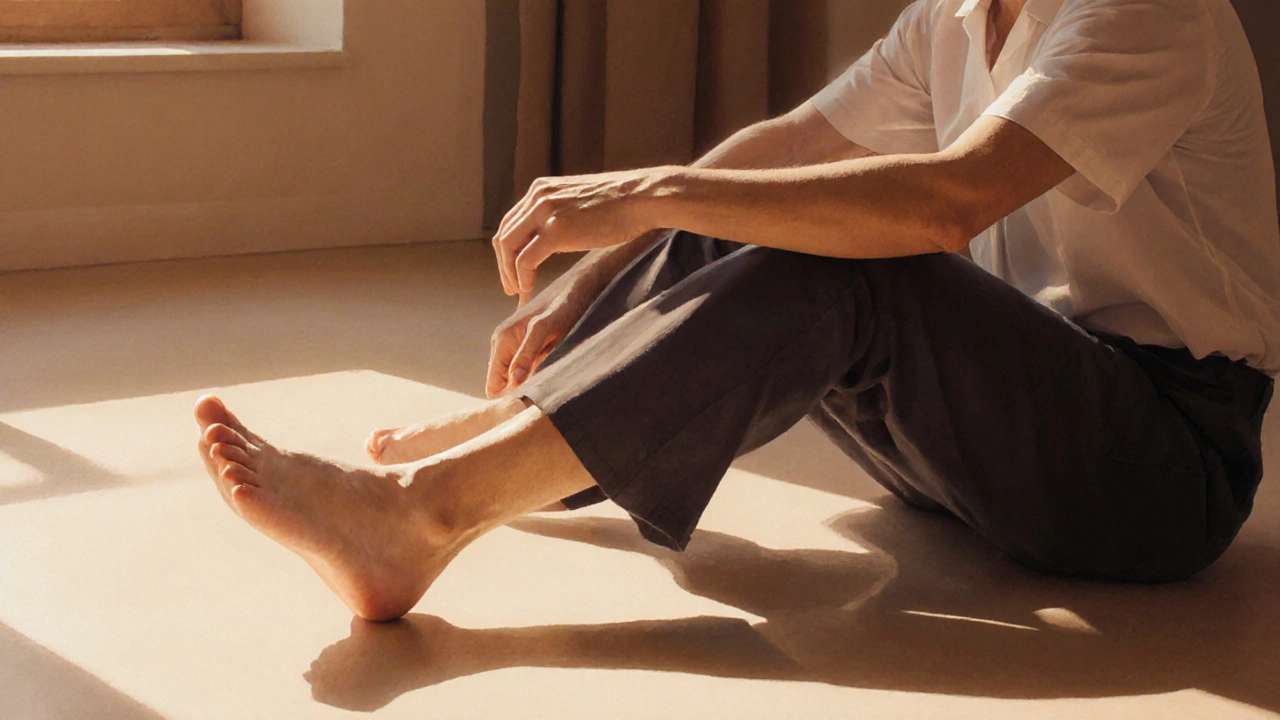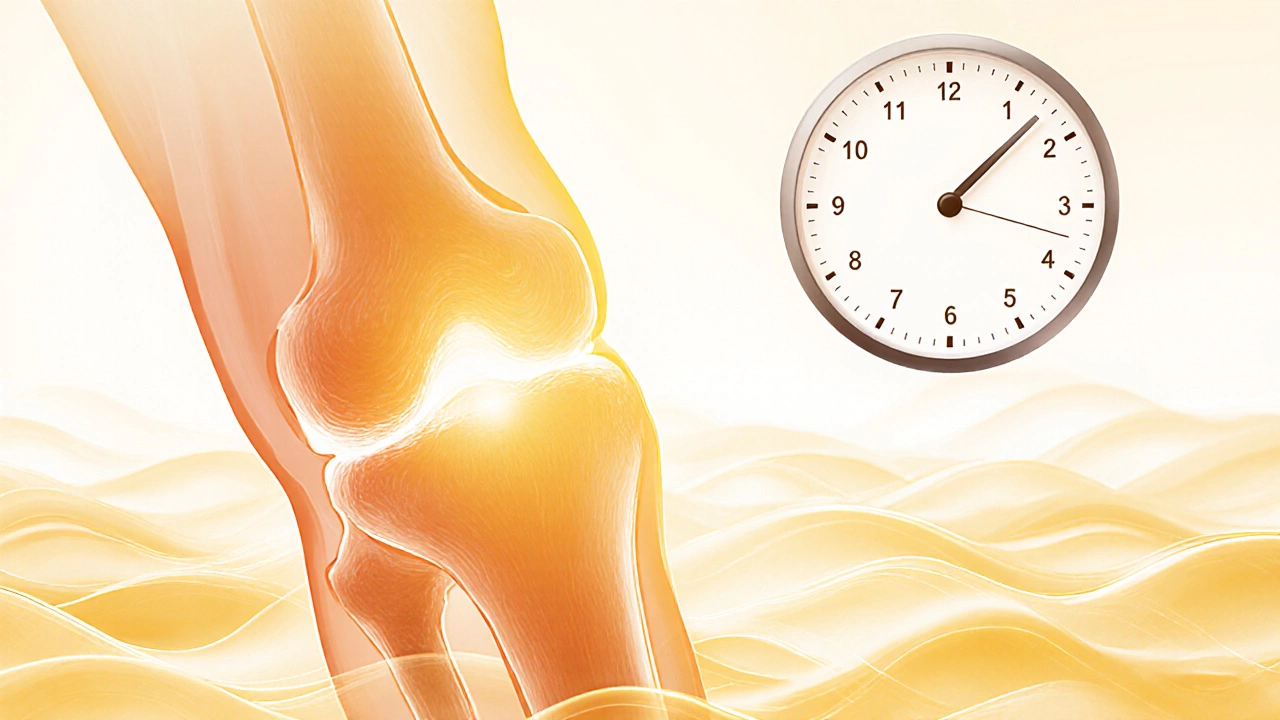Should I Force My Knee to Bend After Knee Replacement?
 Oct, 28 2025
Oct, 28 2025
After knee replacement surgery, you’re told to move your knee-often repeatedly. But what if it hurts? What if it won’t bend? Should you push through the pain and force it? The short answer: no. Forcing your knee to bend after replacement can do more harm than good.
Why bending matters after knee replacement
Your new knee joint is designed to move, but it doesn’t know how yet. Muscles tighten, scar tissue forms, and fluid builds up. All of this locks the joint in place. That’s why physical therapy starts the day after surgery. You’re not trying to rebuild strength right away-you’re trying to prevent stiffness. Most patients regain 110 to 120 degrees of flexion within six weeks. That’s enough to sit comfortably, climb stairs, and get out of a chair without help. You don’t need 135 degrees like a gymnast. You need functional mobility. Forcing beyond what your body allows won’t get you there faster-it’ll just cause swelling, inflammation, and possibly damage to the implant or surrounding tissue.What happens when you force your knee
I’ve seen patients come in weeks after surgery with worse stiffness than when they left the hospital. Why? They spent hours every day trying to push their knee down with their hands, using weights, or sitting on the floor and forcing their leg straight. They thought more pressure = better results. Here’s what actually happens:- Swelling increases because the joint gets irritated
- Scar tissue thickens in response to trauma
- Pain becomes chronic, making you avoid movement altogether
- Quadriceps muscles shut down from fear of pain
- You risk loosening the implant or tearing the soft tissues holding it in place
How to bend your knee safely
You don’t need to force anything. You need consistency. Here’s how to do it right:- Start with passive motion right after surgery. A machine (CPM) or your therapist will gently move your leg while you relax. This is not exercise-it’s protection.
- Use gravity. Lie on your back, put a rolled towel under your heel, and let your knee drop down naturally. Don’t push. Just relax. Hold for 10 minutes, three times a day.
- Sit on a chair and slide your foot backward slowly. Let your heel glide toward your butt. Stop when you feel tension, not pain. Hold for 5 seconds. Repeat 10 times.
- Use a foam roller or pillow under your calf while lying down. Let your knee sink gently into the support. This helps stretch the back of the knee without strain.
- Walk daily. Short, frequent walks (five to ten minutes every few hours) are better than one long session. Movement keeps fluid moving and prevents stiffness.

What to expect week by week
Recovery isn’t linear. Some days feel better than others. That’s normal. Here’s what most patients see:- Week 1: 90 degrees of bend. You’ll need help to get there. Don’t worry if you’re at 70.
- Week 2-3: 100-110 degrees. Walking without crutches becomes possible.
- Week 4-6: 110-120 degrees. You can sit in a car, use stairs, and get up from a low chair.
- Week 8-12: Full range if you’ve been consistent. Some people hit 125+ by six months.
When to worry
Not all stiffness is normal. Contact your surgeon or physiotherapist if:- You can’t bend past 90 degrees after six weeks
- Your knee is red, hot, or swollen without reason
- You have fever or drainage from the incision
- Pain gets worse instead of better after two weeks
- Your leg feels numb or tingly

What helps more than forcing
There are three things that make a bigger difference than brute force:- Heat before rehab: A warm towel or heating pad on your knee for 10 minutes before stretching loosens tissues and makes movement easier.
- Ice after rehab: 15 minutes of ice reduces swelling that causes stiffness. Do this after every session.
- Consistency over intensity: Doing 10 minutes of gentle movement four times a day beats one hour of painful forcing once a day.
Why your therapist’s advice is better than your gut
Your brain wants to protect you. It tells you: “If it hurts, stop.” But after surgery, some discomfort is part of healing. The problem is your brain doesn’t know the difference between harmful pain and normal stretching pain. Good therapists teach you to read your body:- Good pain: A dull ache during movement that fades within 30 minutes after stopping.
- Bad pain: Sharp, stabbing, or burning pain that lasts hours or wakes you up at night.
Final thought: Patience is your best tool
Knee replacement isn’t a race. It’s a marathon with rest stops. Forcing your knee won’t get you to the finish line faster. It might make you quit early. The goal isn’t to bend it as far as possible. It’s to bend it enough to live without pain, without help, and without fear. That happens with time, gentle movement, and smart care-not pressure.Trust the process. Let your body heal on its schedule. You’ll get there.
Can I bend my knee too much after replacement?
You can’t bend your knee too far if you’re doing it gently and without pain. Most implants allow up to 135 degrees of flexion. But forcing it beyond what feels comfortable-especially in the first six weeks-can cause swelling and scar tissue buildup. Focus on steady progress, not maximum bend.
Why is my knee stiff after surgery?
Stiffness is normal in the first few weeks. Fluid builds up, muscles spasm, and scar tissue forms around the joint. This isn’t a sign your surgery failed-it’s part of healing. Movement, heat, and ice help break it down. If stiffness lasts beyond six weeks, talk to your therapist about targeted mobilization techniques.
How long does it take to regain full knee bend?
Most people reach 110-120 degrees by six weeks. Full range (125+ degrees) often takes three to six months. Some people never get past 110 and still live pain-free. What matters is function, not numbers on a goniometer.
Is it normal to have pain when bending my knee?
Mild discomfort during movement is normal, especially in the first four weeks. It should feel like a stretch, not a sharp stab. If pain lasts more than 30 minutes after activity, or gets worse over time, it’s a red flag. Reduce intensity and ice the area. Don’t ignore persistent pain.
Can I use a knee brace to help me bend my knee?
Most patients don’t need a brace after knee replacement. Braces can create dependency and reduce muscle activation. If your therapist recommends one, it’s likely for stability, not bending. Never use a brace to force your knee into position-that can damage the implant or soft tissues.